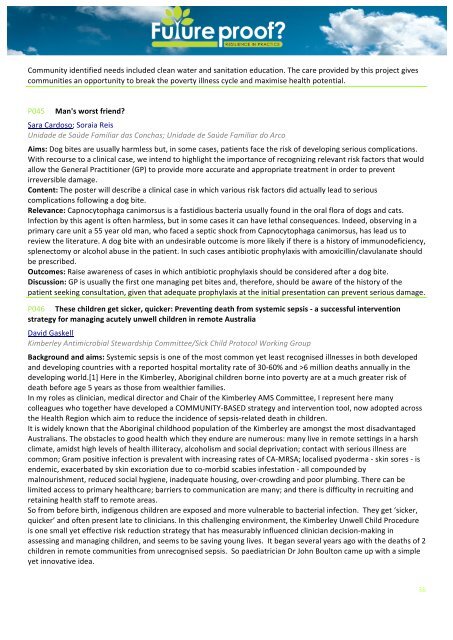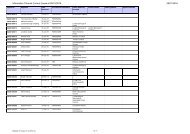RCGP-2014-poster-abstracts
RCGP-2014-poster-abstracts
RCGP-2014-poster-abstracts
You also want an ePaper? Increase the reach of your titles
YUMPU automatically turns print PDFs into web optimized ePapers that Google loves.
Community identified needs included clean water and sanitation education. The care provided by this project gives <br />
communities an opportunity to break the poverty illness cycle and maximise health potential. <br />
P045 <br />
Man's worst friend <br />
Sara Cardoso; Soraia Reis <br />
Unidade de Saúde Familiar das Conchas; Unidade de Saúde Familiar do Arco <br />
Aims: Dog bites are usually harmless but, in some cases, patients face the risk of developing serious complications. <br />
With recourse to a clinical case, we intend to highlight the importance of recognizing relevant risk factors that would <br />
allow the General Practitioner (GP) to provide more accurate and appropriate treatment in order to prevent <br />
irreversible damage. <br />
Content: The <strong>poster</strong> will describe a clinical case in which various risk factors did actually lead to serious <br />
complications following a dog bite. <br />
Relevance: Capnocytophaga canimorsus is a fastidious bacteria usually found in the oral flora of dogs and cats. <br />
Infection by this agent is often harmless, but in some cases it can have lethal consequences. Indeed, observing in a <br />
primary care unit a 55 year old man, who faced a septic shock from Capnocytophaga canimorsus, has lead us to <br />
review the literature. A dog bite with an undesirable outcome is more likely if there is a history of immunodeficiency, <br />
splenectomy or alcohol abuse in the patient. In such cases antibiotic prophylaxis with amoxicillin/clavulanate should <br />
be prescribed. <br />
Outcomes: Raise awareness of cases in which antibiotic prophylaxis should be considered after a dog bite. <br />
Discussion: GP is usually the first one managing pet bites and, therefore, should be aware of the history of the <br />
patient seeking consultation, given that adequate prophylaxis at the initial presentation can prevent serious damage. <br />
P046 These children get sicker, quicker: Preventing death from systemic sepsis -‐ a successful intervention <br />
strategy for managing acutely unwell children in remote Australia <br />
David Gaskell <br />
Kimberley Antimicrobial Stewardship Committee/Sick Child Protocol Working Group <br />
Background and aims: Systemic sepsis is one of the most common yet least recognised illnesses in both developed <br />
and developing countries with a reported hospital mortality rate of 30-‐60% and >6 million deaths annually in the <br />
developing world.[1] Here in the Kimberley, Aboriginal children borne into poverty are at a much greater risk of <br />
death before age 5 years as those from wealthier families. <br />
In my roles as clinician, medical director and Chair of the Kimberley AMS Committee, I represent here many <br />
colleagues who together have developed a COMMUNITY-‐BASED strategy and intervention tool, now adopted across <br />
the Health Region which aim to reduce the incidence of sepsis-‐related death in children. <br />
It is widely known that the Aboriginal childhood population of the Kimberley are amongst the most disadvantaged <br />
Australians. The obstacles to good health which they endure are numerous: many live in remote settings in a harsh <br />
climate, amidst high levels of health illiteracy, alcoholism and social deprivation; contact with serious illness are <br />
common; Gram positive infection is prevalent with increasing rates of CA-‐MRSA; localised pyoderma -‐ skin sores -‐ is <br />
endemic, exacerbated by skin excoriation due to co-‐morbid scabies infestation -‐ all compounded by <br />
malnourishment, reduced social hygiene, inadequate housing, over-‐crowding and poor plumbing. There can be <br />
limited access to primary healthcare; barriers to communication are many; and there is difficulty in recruiting and <br />
retaining health staff to remote areas. <br />
So from before birth, indigenous children are exposed and more vulnerable to bacterial infection. They get ‘sicker, <br />
quicker’ and often present late to clinicians. In this challenging environment, the Kimberley Unwell Child Procedure <br />
is one small yet effective risk reduction strategy that has measurably influenced clinician decision-‐making in <br />
assessing and managing children, and seems to be saving young lives. It began several years ago with the deaths of 2 <br />
children in remote communities from unrecognised sepsis. So paediatrician Dr John Boulton came up with a simple <br />
yet innovative idea. <br />
36



